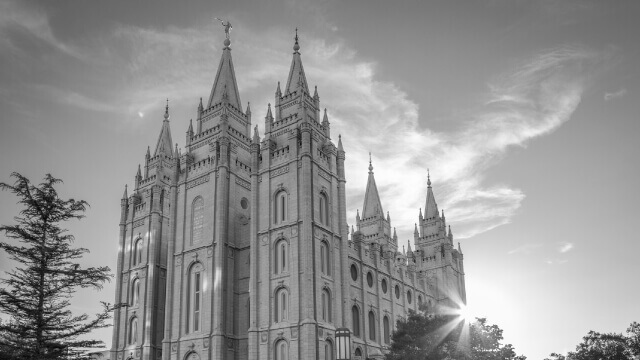In today's Getting It Right: The Deseret News writes that 2012 was more than a Mormon moment; KALW Public Radio has a piece about how Mormon temples differ from regular Mormon meetinghouses; The Post News Group describes how the Church blesses others through welfare services; and a Washington Post article underlines the importance of precise reporting about the Church’s stance on same-sex attraction.
Deseret News: 2012 was more than a Mormon moment and cleared up misunderstandings
Joseph Walker of the Deseret News writes about why 2012 was “more than a Mormon moment.” Walker quotes a Washington Post column from Church Public Affairs managing director Michael R. Otterson, who wrote that “after a 180-year history and 12 years of calling it a ‘moment,’ we should re-examine the paradigm.” In a different Washington Post piece, Otterson says, “Church leadership has never believed that this period is merely a ‘Mormon moment.’ They have much more of a long-range view.”
Walker also writes that the heightened media attention on the Church has benefited interfaith relations. Walker speaks with Richard Mouw, president of the Fuller Theological Seminary in Pasadena, California, who says much of the coverage of the Church during 2012 helped in “clearing up the misunderstandings.”
“There’s a general recognition that Mormonism has moved into the mainstream in terms of its involvement in public life and education, leadership on both sides of the political aisle, and the ways in which it is increasingly demonstrating a nuanced approach to the roles of religious pluralism in American life,” Mouw says. “While we continue to have — and will likely always have — some really serious theological issues with each other, I believe there are many in the evangelical community who are saying that while we have traditionally been your worst enemies, we are becoming your best friends.”
- Read Walker’s full article.
- Also read a MormonNewsroom.org topic page about the Church’s interfaith efforts.
(Audio) KALW Public Radio: Mormon temples are places of peace and quiet, and differ from regular Mormon meetinghouses
As part of a series from KALW Public Radio in San Francisco about “places that intrigue,” reporter Isabel Angell speaks with local Latter-day Saint Jay Pimentel about the Church’s Oakland California Temple.
Pimentel points out that Mormon temples are different from the chapels Mormons worship in on Sundays. Temples, in fact, are closed on Sundays. And inside temples the Church’s highest and most sacred ordinances — such as marriage — take place. “A marriage performed in a Mormon temple is not said to be till death do you part, but … carry on into the eternities,” Pimentel says.
Additionally, Pimentel notes that temples are places of peace and quiet, where one can unplug from the noise of everyday life. “This is a busy and hectic area to live in, the San Francisco Bay Area. It’s vibrant, it’s exciting, it’s why I like to live here, it’s terrific,” Pimentel says. “But to have a place of respite, to have a place where it is just this quiet, that is one of the sounds I like the very best.”
The Post News Group: Blessing others through welfare services
A report about the recent visit to Church headquarters in Salt Lake City by several Baptist ministers from California contains correct descriptions of the Church’s welfare service, employment centers and addiction recovery programs.
“Welfare Square,” the article notes, “is comprised of the Bishop’s Storehouse, which can be compared to a grocery store without a cash register; a bakery, which bakes as many as 1,500 loaves of bread per day to meet local needs; a cannery; a milk-processing plant; and a thrift store. The entire facility is operated by a handful of paid staff and an army of volunteers.” The article also correctly says that the Church’s employment resource centers and addiction recovery programs are open to anyone in need of help.
Read the entire article the Post News Group.
Washington Post: The importance of precise reporting about the Church’s stance on same-sex attraction
Much of the news coverage surrounding the Church's 6 December 2012 launch of mormonsandgays.org has accurately relayed the Church’s teachings in regard to same-sex attraction. Most recently, a Washington Post report correctly says, “the church extended an olive branch to its gay members without changing its teaching that sex is reserved for marriage between a man and a woman.” The Post then quotes mormonsandgays.org: “The experience of same-sex attraction is a complex reality for many people. The attraction itself is not a sin, but acting on it is. Even though individuals do not choose to have such attractions, they do choose how to respond to them. With love and understanding, the Church reaches out to all God’s children, including our gay and lesbian brothers and sisters.”
It is also true that some news reports have given the impression that the Church has changed its stance on same-sex attraction. We caution reporters and readers to remember that the Church’s position on the issue of same-sex attraction has not changed. The Church’s doctrinal position is clear and unchanging: Sexual activity should occur only between a man and a woman who are married. The Church teaches that same-sex attraction is not a sin, but acting on it is.
We also remind journalists and readers of the vital message on mormonsandgays.org that those with same-sex attraction “need our love and understanding. God loves all His children alike, much more than any of us can comprehend, and expects us to follow.”
